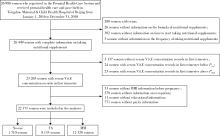北京大学学报(医学版) ›› 2022, Vol. 54 ›› Issue (3): 434-442. doi: 10.19723/j.issn.1671-167X.2022.03.007
围受孕期服用微量营养增补剂与孕早期血清维生素E浓度的关系
邢云飞1,刘春毅1,孟文颖2,张杰1,焦明远3,金蕾4,靳蕾1,*( )
)
- 1. 北京大学生育健康研究所,国家卫生健康委员会生育健康重点实验室,北京 100191
2. 北京市通州区妇幼保健院产科,北京 101100
3. 北京市通州区妇幼保健院检验科,北京 101100
4. 北京市通州区妇幼保健院妇女保健科,北京 101100
Relationship between micronutrients supplementation during periconceptional period and serum concentration of vitamin E in the 1st trimester of gestational period
Yun-fei XING1,Chun-yi LIU1,Wen-ying MENG2,Jie ZHANG1,Ming-yuan JIAO3,Lei JIN4,Lei JIN1,*( )
)
- 1. Institute of Reproductive and Child Health, Peking University; National Health Commission Key Laboratory of Reproductive Health, Beijing 100191, China
2. Department of Obstetrics, Tongzhou Maternal & Child Health Hospital of Beijing, Beijing 101100, China
3. Department of Clinical Laboratory, Tongzhou Maternal & Child Health Hospital of Beijing, Beijing 101100, China
4. Department of Maternal Health Care, Tongzhou Maternal & Child Health Hospital of Beijing, Beijing 101100, China
摘要:
目的: 探究妇女围受孕期服用微量营养增补剂对孕早期血清维生素E(vitamin E,Vit.E)水平的影响。方法: 以2016年1月至2018年12月北京市通州区妇幼保健院的孕期保健和医院信息系统中22 171位分娩妇女的孕期保健及血液检查数据为基础进行回顾性队列研究,以围受孕期服用营养增补剂[单纯叶酸(folic acid,FA)或复方微量营养增补剂(multiple micronutrients,MM)]情况为自变量,孕早期血清Vit.E浓度和血清Vit.E浓度是否≥11.2 mg/L为结局变量,分别采用广义线性回归模型和Logistic回归模型分析自变量与结局变量的关系。结果: 妇女孕早期血清Vit.E浓度为5.2~24.0 mg/L,中位浓度为10.1(8.8~11.6) mg/L。服用MM的妇女孕早期血清Vit.E过量率为0.3%,未服用营养增补剂和服用单纯FA的妇女Vit.E过量率为0.1%。关于血清Vit.E浓度,服用MM的妇女比未服用营养增补剂及服用FA者高(P均 < 0.05),孕前开始服用FA或MM比孕后开始服用高(P均 < 0.05),规律服用比不规律服用高(P均 < 0.05),且服用FA和服用MM的两组妇女血清Vit.E浓度均随服用依从性提高而升高(P < 0.05)。关于孕早期血清Vit.E浓度≥11.2 mg/L的风险,服用MM的妇女风险高于未服用营养增补剂及服用单纯FA者(OR=1.36,95%CI:1.21~1.53;OR=1.39,95%CI:1.31~1.48),孕前开始服用FA或MM者比孕后开始服用高(OR=0.86,95%CI:0.77~0.96;OR=0.88,95%CI:0.81~0.95),规律服用较不规律服用风险高(OR=1.16,95%CI:1.05~1.29;OR=1.13,95%CI:1.04~1.22);且随依从性提高,服用MM者该风险升高(OR=1.10,95%CI:1.07~1.14),但服用FA者该风险未见升高(OR=1.04,95%CI:1.00~1.08)。结论: 北京地区妇女孕早期Vit.E营养状况总体较好,其中服用MM的妇女孕早期血清Vit.E过量率较高,提示围受孕期妇女应考虑自身Vit.E营养状况选择营养增补剂配方,以免导致相关健康危害。
中图分类号:
- R169
| 1 |
Steegers-Theunissen RP , Twigt J , Pestinger V , et al. The periconceptional period, reproduction and long-term health of offspring: The importance of one-carbon metabolism[J]. Hum Reprod Update, 2013, 19 (6): 640- 655.
doi: 10.1093/humupd/dmt041 |
| 2 | Chen H , Qian N , Yan L , et al. Role of serum vitamin A and E in pregnancy[J]. Exp Ther Med, 2018, 16 (6): 5185- 5189. |
| 3 | 李俊, 郑春梅, 倪君君, 等. 2013-2016年北京地区孕妇维生素A、维生素E营养水平[J]. 卫生研究, 2019, 48 (1): 56- 60. |
| 4 | 李浩, 倪君君, 郑春梅. 2016年我国北方地区孕妇维生素A、E营养状况调查[J]. 中国医药导报, 2019, 16 (9): 64- 67. |
| 5 | 申南, 陆娣, 郑春梅, 等. 常规保健下不同年龄段孕妇妊娠早期血清维生素A、E水平分析[J]. 中国妇产科临床杂志, 2018, 19 (4): 356- 358. |
| 6 | 贾军恒, 田文琴, 强莉. 不同孕期妇女血清维生素A、维生素E水平的临床观察[J]. 中国妇幼保健, 2019, 34 (3): 509- 511. |
| 7 | 钮慧远, 薛秀平, 仲晓慧. 2017-2018年淮安地区孕妇维生素A、维生素E水平及其影响因素[J]. 卫生研究, 2020, 49 (1): 41- 43. |
| 8 | 孟文颖, 黄琬桐, 张杰, 等. 孕早期血清维生素E水平与妊娠期高血压疾病发病风险的关系[J]. 北京大学学报(医学版), 2020, 52 (3): 470- 478. |
| 9 |
Sharifipour F , Abedi P , Ciahkal SF , et al. Serum vitamin E level and gestational diabetes mellitus: A systematic review and meta-analysis[J]. J Diabetes Metab Disord, 2020, 19 (2): 1787- 1795.
doi: 10.1007/s40200-020-00582-5 |
| 10 | 施文瑶, 施晓华, 朱晓燕, 等. 孕期血清维生素A、D、E水平与妊娠期糖尿病的相关性研究[J]. 中国卫生检验杂志, 2021, 31 (4): 473- 475. |
| 11 |
Pazdro R , Burgess JR . The role of vitamin E and oxidative stress in diabetes complications[J]. Mech Ageing Dev, 2010, 131 (4): 276- 286.
doi: 10.1016/j.mad.2010.03.005 |
| 12 |
Nourooz-Zadeh J , Rahimi A , Tajaddini-Sarmadi J , et al. Relationships between plasma measures of oxidative stress and metabo-lic control in NIDDM[J]. Diabetologia, 1997, 40 (6): 647- 653.
doi: 10.1007/s001250050729 |
| 13 | Kutbi HA , Hammouda SA . Plasma concentrations of vitamin A and E and risk of dysglycemia in first-trimester pregnant Saudi women[J]. Diabetol Metab Syndr, 2020, (12): 17. |
| 14 | 吕祺, 阴春霞, 周硕, 等. 孕妇血清维生素D和维生素E水平与妊娠期高血压疾病发生的相关性[J]. 中国妇幼保健, 2021, 36 (16): 3662- 3665. |
| 15 |
Gilboa SM , Lee KA , Cogswell ME , et al. Maternal intake of vitamin E and birth defects, national birth defects prevention study, 1997 to 2005[J]. Birth Defects Res A Clin Mol Teratol, 2014, 100 (9): 647- 657.
doi: 10.1002/bdra.23247 |
| 16 | Rigotti A . Absorption, transport, and tissue delivery of vitamin E[J]. Molecular aspects of medicine, 2007, 28 (5): 423- 436. |
| 17 |
Traber MG , Rader D , Acuff RV , et al. Vitamin E dose-response studies in humans with use of deuterated RRR-alpha-tocopherol[J]. Am J Clin Nutr, 1998, 68 (4): 847- 853.
doi: 10.1093/ajcn/68.4.847 |
| 18 |
李军生. 维生素E吸收与代谢机制的研究进展[J]. 中国现代应用药学, 2005, 22 (6): 457- 461.
doi: 10.3969/j.issn.1007-7693.2005.06.008 |
| 19 | 陈曦, 宫照龙, 沈葹. 超高效液相色谱-三重四级杆串联质谱法测定血清中维生素A和维生素E[J]. 卫生研究, 2021, 50 (2): 301- 307. |
| 20 | 金蕾, 王程, 张杰, 等. 妇女围受孕期叶酸服用情况及其对胎儿神经管缺陷的预防效果[J]. 北京大学学报(医学版), 2020, 52 (4): 719- 725. |
| 21 |
Wang L , Leng J , Liu H , et al. Association between hypertensive disorders of pregnancy and the risk of postpartum hypertension: A cohort study in women with gestational diabetes[J]. J Hum Hypertens, 2017, 31 (11): 725- 730.
doi: 10.1038/jhh.2017.46 |
| 22 | 闫明, 张雯, 刘凯波, 等. 北京地区2010-2017年增补叶酸预防神经管缺陷工作效果分析[J]. 中国优生与遗传杂志, 2019, 27 (3): 339- 341. |
| 23 |
Bian H , Tang Y , Zhou Y , et al. Demographic variations and temporal trends in prenatal use of multiple micronutrient supplements in Beijing, 2013-2017[J]. Public Health Nutr, 2021, 24 (5): 826- 833.
doi: 10.1017/S1368980020004905 |
| 24 |
Schulze KJ , Mehra S , Shaikh S , et al. Antenatal multiple micronutrient supplementation compared to iron-folic acid affects micronutrient status but does not eliminate deficiencies in a randomized controlled trial among pregnant women of rural bangladesh[J]. J Nutr, 2019, 149 (7): 1260- 1270.
doi: 10.1093/jn/nxz046 |
| 25 | Colapinto CK , O'Connor DL , Dubois L , et al. Prevalence and correlates of folic acid supplement use in Canada[J]. Health Rep, 2012, 23 (2): 39- 44. |
| [1] | 白银晓,刘春毅,张杰,孟文颖,金蕾,靳蕾. 妇女围受孕期服用叶酸或含叶酸的多种微量营养素补充剂与早产的关联性研究[J]. 北京大学学报(医学版), 2023, 55(3): 495-501. |
| [2] | 王晓伟,穆英超,郭振宇,周玉博,张勇,李宏田,刘建蒙. 中国山东某县1951年以来出生女性初潮年龄与绝经年龄长期趋势[J]. 北京大学学报(医学版), 2023, 55(3): 502-510. |
| [3] | 金蕾,王程,张杰,孟文颖,张佳煜,于锦慧,蔺桂银,佟明坤,靳蕾. 妇女围受孕期叶酸服用情况及其对胎儿神经管缺陷的预防效果[J]. 北京大学学报(医学版), 2020, 52(4): 719-725. |
| [4] | 陈章健,韩硕,郑湃,周淑佩,贾光. 纳米二氧化钛与葡萄糖亚慢性联合经口暴露对幼年大鼠血清叶酸和维生素B12水平的影响[J]. 北京大学学报(医学版), 2020, 52(3): 451-456. |
| [5] | 孟文颖,黄琬桐,张杰,焦明远,金蕾,靳蕾. 孕早期血清维生素E水平与妊娠期高血压疾病发病风险的关系[J]. 北京大学学报(医学版), 2020, 52(3): 470-478. |
| [6] | 朱洁,李建红,袁婷婷,和璐,梁宇红. 绝经期妇女牙周状况与骨质密度的相关性分析[J]. 北京大学学报(医学版), 2019, 51(6): 1115-1118. |
| [7] | 黄海文,闫兵,尚美霞,刘漓波,郝瀚,席志军. 女性膀胱癌患者腹腔镜膀胱全切术与开放膀胱全切术的倾向性评分匹配比较[J]. 北京大学学报(医学版), 2019, 51(4): 698-705. |
| [8] | 孙颖,靳蕾. 中国北方3县妊娠妇女血液锰浓度及其影响因素[J]. 北京大学学报(医学版), 2018, 50(3): 463-468. |
| [9] | 袁蒙蒙,王锰,刘俊义,张志丽. 基于4-氨基-5-甲酰基-8,10-二去氮杂四氢叶酸二乙酯侧链的水解反应条件优化[J]. 北京大学学报(医学版), 2017, 49(4): 714-718. |
| [10] | 刘鑫,杜义青,李远新,王锰,张志丽,王孝伟,刘俊义,田超. N-[4-(2,4-二氨基吡啶并[3,2-d]嘧啶-6-甲氨基)-苯甲酰]-L-谷氨酸二乙酯的合成方法改进[J]. 北京大学学报(医学版), 2015, 47(5): 842-845. |
| [11] | 任爱国. 叶酸预防神经管缺陷[J]. 北京大学学报(医学版), 2014, 46(3): 343-346. |
| [12] | 王琳琳, 杨娜, 袁悦, 任爱国. 人叶酸受体自身抗体IgG酶联免疫吸附试验检测方法的建立及评价[J]. 北京大学学报(医学版), 2014, 46(3): 483-487. |
| [13] | 王苹, 王红, 吴雅慧, 叶晓茜, 黄尚志, 石冰, 梁赓义, 曹卫华, 吴涛, Terri H. BEATY. 中国人群叶酸/同型半胱氨酸代谢基因多态性与非综合征型唇腭裂关联研究[J]. 北京大学学报(医学版), 2013, 45(03): 352-358. |
| [14] | 高燕秋, Tamara Jacka. 西部农村地区家庭暴力发生情况及对妇女精神健康的影响[J]. 北京大学学报(医学版), 2012, 44(3): 379-386. |
| [15] | Christopher P. HOWSON, Nanbert ZHONG, Carmencita PADILLA, Khalid YUNIS, Roberto GIUGLIANI . 凝聚专家的力量提高低收入国家的妇幼保健质量——美国出生缺陷基金会资助的全球妇幼保健协作项目(英文稿)[J]. 北京大学学报(医学版), 2009, 41(4): 392-394. |
|
||




